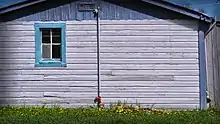Shiplap
Shiplap is a type of wooden board used commonly as exterior siding in the construction of residences, barns, sheds, and outbuildings.

Exterior walls
Shiplap is either rough-sawn 25 mm (1 in) or milled 19 mm (3⁄4 in) pine or similarly inexpensive wood between 76 and 254 mm (3 and 10 in) wide with a 9.5–12.7 mm (3⁄8–1⁄2 in) rabbet on opposite sides of each edge.[1] The rabbet allows the boards to overlap in this area. The profile of each board partially overlaps that of the board next to it creating a channel that gives shadow line effects, provides excellent weather protection and allows for dimensional movement.
Useful for its strength as a supporting member, and its ability to form a relatively tight seal when lapped, shiplap is usually used as a type of siding for buildings that do not require extensive maintenance and must withstand cold and aggressive climates. Rough-sawn shiplap is attached vertically in post and beam construction, usually with 51–65 mm (6d–8d) common nails, while milled versions, providing a tighter seal, are more commonly placed horizontally, more suited to two-by-four frame construction.
Small doors and shutters such as those found in barns and sheds are often constructed of shiplap cut directly from the walls, with only thin members framing or crossing the back for support. Shiplap is also used indoors for the rough or rustic look that it creates when used as paneling or a covering for a wall or ceiling. Shiplap is often used to describe any rabbeted siding material that overlaps in a similar fashion.
Interior design
In interior design, shiplap is a style of wooden wall siding characterized by long planks, normally painted white, that are mounted horizontally with a slight gap between them in a manner that evokes exterior shiplap walls. A disadvantage of the style is that the gaps are prone to accumulating dust.[2]
Installing shiplap horizontally in a room can help carry the eye around the space, making it feel larger. Installing it vertically helps emphasize the height of the room, making it feel taller. Rectangular shiplap pieces can be placed in a staggered zig-zag layout to add texture and enhance the size of the room.[3] Shiplap can also be installed on the ceiling, to draw the eye upwards.[4]
References
- Shiplap Edge Joints, WoodworkDetails.com
- Frake, Dabney (22 May 2018). "The Downside to Shiplap Walls You Might Not Know About". Apartment Therapy. Retrieved 11 July 2018.
- Ivanisov, Zakhar (5 Jan 2023). "13 Herringbone Shiplap Walls to Create Instant Interest". www.soulandlane.com. Retrieved 21 February 2023.
- Quigley, Annie (20 Dec 2018). "10 Things Nobody Tells You About Shiplap". Remodelista. Retrieved 24 January 2019.